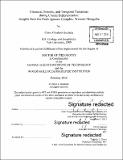Chemical, isotopic, and temporal variations during crustal differentiation : insights from the Dariv Igneous Complex, Western Mongolia
Author(s)
Bucholz, Claire Elizabeth
DownloadFull printable version (25.51Mb)
Other Contributors
Woods Hole Oceanographic Institution.
Terms of use
Metadata
Show full item recordAbstract
Fractional crystallization of mantle-derived basaltic melts is a critical process in producing a compositionally stratified continental crust characterized by a silicic upper crust and a mafic lower crust. This thesis explores outstanding questions associated with fractional crystallization through detailed field, petrological, and geochemical studies of the Dariv Igneous Complex in Western Mongolia. The Dariv Igneous Complex records the crystallization of a high-K primitive arc melt at shallow crustal levels, preserving both biotite-bearing ultramafic and mafic cumulates, as well as liquid-like evolved plutonics, such as (quartz-)monzonites. Chapter 2 presents comprehensive field and petrographic descriptions of the complex and establishes the petrogenetic groundwork to understand the conditions under which it formed. Results of this study indicate that the observed lithologies formed through the fractional crystallization of a high-K hydrous basalt, typical of alkali-rich basalts found in subduction zone settings, at 0.2-0.5 GPa and elevated oxygen fugacities. Chapter 3 presents a quantitatively modeled liquid line of descent (LLD) for the complex based on whole rock geochemical analyses, which is able to explain the trends observed in the monzonitic plutonic series observed in continental arcs. The oxygen isotope trajectory of fractionally crystallizing melts is rigorously constrained through modeling and mineral analyses in Chapter 4. This study indicates that large (1 to 1.8%o) increases in [delta]18O as a melt evolves from basaltic to granitic in composition due to the fractionation of low [delta]18O minerals. As such, the majority of [delta]180 values of upper crustal silicic plutonics can be explained through fractional crystallization of primitive arc basalts alone without needing to invoke assimilation of high [delta]18O crustal material. Finally, Chapter 5 explores the timescales associated with fractional crystallization through high precision U-Pb geochronology of zircon from the Dariv Igneous Complex. Evolution from a basaltic melt to a silica-rich monzonitic melt in the Dariv Igneous Complex occurred in <300 ka. If rates of fractional crystallization are primarily a function of cooling, this study provides an end-member constraint for fractional crystallization of a basaltic melt at relatively cool, shallow crustal levels. Together, these studies advance our understanding of the compositional, isotopic, and temporal variations associated with the formation of the continental crust.
Description
Thesis: Ph. D. in Geochemistry, Joint Program in Marine Geology and Geophysics (Massachusetts Institute of Technology, Department of Earth, Atmospheric, and Planetary Sciences; and the Woods Hole Oceanographic Institution), 2016. "February 2016." Cataloged from PDF version of thesis. Includes bibliographical references.
Date issued
2016Department
Joint Program in Marine Geology and Geophysics; Woods Hole Oceanographic Institution; Massachusetts Institute of Technology. Department of Earth, Atmospheric, and Planetary SciencesPublisher
Massachusetts Institute of Technology
Keywords
Joint Program in Marine Geology and Geophysics., Earth, Atmospheric, and Planetary Sciences., Woods Hole Oceanographic Institution.